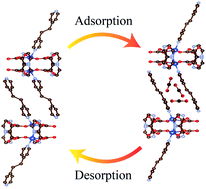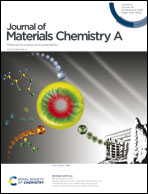Lattice expansion and ligand twist during CO2 adsorption in flexible Cu bipyridine metal–organic frameworks†
Abstract
Flexible metal–organic frameworks (MOFs) can show exceptional selectivity and capacity for adsorption of CO2. The incorporation of CO2 into flexible MOFs that have Cu2+ coordination centers and organic pillar ligands is accompanied by a distortion of the framework lattice arising from chemical interactions between these components and CO2 molecules. CO2 adsorption yields a reproducible lattice expansion that is enabled by the rotation of the pillar ligands. The structures of Cu2(pzdc)2(bpy) and Cu2(pzdc)2(bpe), CPL-2 and CPL-5, were evaluated using in situ synchrotron X-ray powder diffraction at room temperature at CO2 gas pressures up to 50 atm. The structural parameters exhibit hysteresis between pressurization and depressurization. The pore volume within CPL-2 and CPL-5 increases at elevated CO2 pressure due to a combination of the pillar ligand rotation and the overall expansion of the lattice. Volumetric CO2 adsorption measurements up to 50 atm reveal adsorption behavior consistent with the structural results, including a rapid uptake of CO2 at low pressure, saturation above 20 atm, and hysteresis evident as a retention of CO2 during depressurization. A significantly greater CO2 uptake is observed in CPL-5 in comparison with predictions based on CO2 pressure-induced expansion of the pore volume available for adsorption, indicating that the flexibility of the CPL structures is a key factor in enhancing adsorption capacity.



 Please wait while we load your content...
Please wait while we load your content...